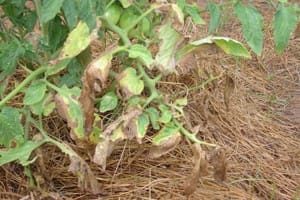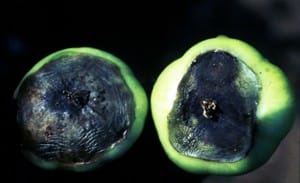Source(s): Robert R Westerfield, College of Agricultural and Environmental Sciences, Extension Horticulturist Diseases and Insects
Although tomatoes are fairly tolerant of insect damage, they will occasionally have trouble from some common garden pests. Whiteflies, hornworms, aphids, leafminers, stinkbugs, loopers, cutworms and mole crickets (south Georgia) have been known to cause problems on tomatoes.


Insecticidal soap and Bt (Bacillus turingiensis) are used by many organic gardeners with fair success. Repeated applications and scouting for pests frequently are necessary for continued control. A general purpose garden insecticide applied according to label directions will control most of these pests. Use care, however, when spraying because these pesticides will also kill many of the beneficial insects that are protecting your garden naturally.
Diseases and viruses on tomatoes can be a real problem for the home gardener. For detailed information on tomato diseases, please refer to a separate publication available from your local county extension office. Cultural practices discussed earlier in this publication, and improved variety selection, will go a long way in preventing disease problems. It makes more sense to maintain a healthy plant and prevent disease problems, than to rely on spraying multiple chemicals for control.
Blossom-End Rot
Blossom-end rot can be a serious problem with tomatoes. The main symptom is a dark, sunken water-soaked area at the blossom end of the fruit. This physiological disorder is associated with a low concentration of calcium in the fruit. Blossom-end rot is also induced more often when there is drought stress followed by excessive soil moisture; these fluctuations reduce uptake and movement of available calcium.
To manage blossom-end rot:
Maintain the soil pH between 6.2 to 6.8 and supply adequate levels of calcium through applications of dolimitic limestone or gypsum.
Avoid drought stress and extreme moisture fluctuations by using mulch and deep, timely irrigation once or twice a week.
Avoid over fertilizing plants with high ammoniacal nitrogen fertilizers. Excessive nitrogen can depress the uptake of calcium.
Foliar applications of calcium with products such as Blossom End Rot Stop, are only short term fixes and often work poorly because of poor absorption and movement to the fruit area where it is needed.
Resource(s):
- Common Tomato Problems - May 9, 2018
- Growing Tomatoes - September 24, 2013
- Japanese Hollies - September 24, 2013